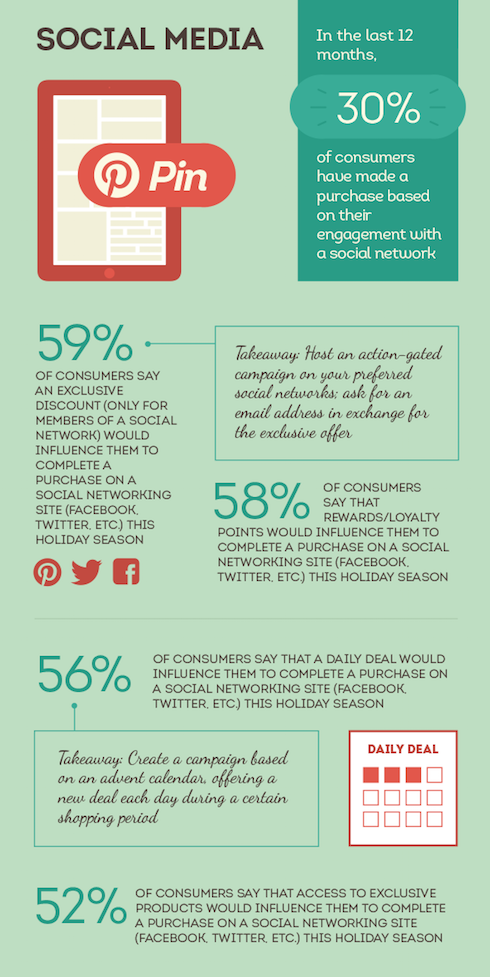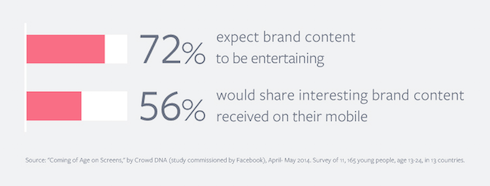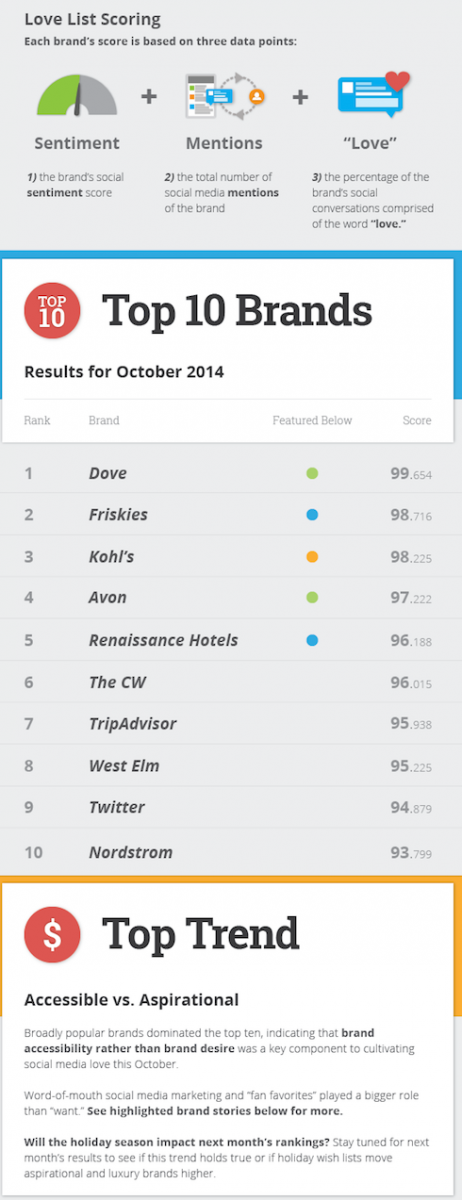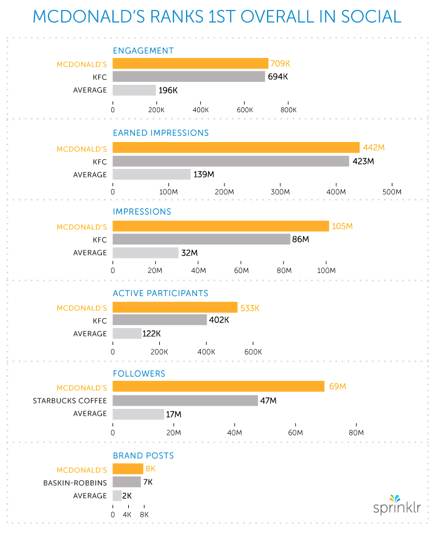By Liam Dowd - November 26th, 2014
Why entertaining social content sells. How McDonalds is an expert social business and how does your corporation know its social media activity is successful?
Holiday shopping
As brands gear up for the Christmas season, the behaviour of shoppers needs to be taken into consideration. Clearly social media has become an essential component of all marketing messages – none more so than at peak purchasing times such as Christmas. Indeed, social media networks have rapidly become a retail channel in their own right.
A new infographic from Socially Stacked offers some insight into how this holiday season’s selling will be influenced by social media activity. Some of the key highlights include:
- 47% of consumers say that the Internet is their favourite shopping destination.
- 52% of consumers say that access to exclusive products would influence them to complete a purchase on a social networking site (Facebook, Twitter, etc.) this holiday season.
- 25% of shoppers say easy-to-use mobile websites is an important factor in their decision to shop with a specific retailer.
This Christmas is also the time to ensure social media is used to comprehensively communicate your corporation’s best deals. Social media is now the place to look for discounts, offers and other promotions, so ensure your brand messages are loud and clear.
Entertain to sell
Some of the most successful ad campaigns yet seen across social media have used humour to entertain their audiences. In their latest study ‘Coming of Age on Screens’ Facebook have taken a look at the DNA of social media users to see what makes them tick.
Facebook says: “Around the world, online is now a favorite place to hang out, second only to friends’ homes. When it comes to where to share, social media is the first place young people turn to share the most important moments and feelings of their lives. When they’ve had a “really good day,” the first place they share the news is on social media (30%), followed by face to face (22%) and text (11%).
“Sharing information is a natural part of their days. Teens and young adults told us they first use social media to share things like interesting news articles (36%) or random observations (28%). Some 44% of young people around the world say they would share a funny video, photo or joke on social media before sharing it in person.
"Young people say they also want brands to be thoughtful about what they post. Some 72% of youth say they expect advertising to be entertaining, suggesting a high bar for marketers. Those numbers are even stronger in high-growth markets, including Indonesia (99%), Brazil (81%) and India (80%)."
The report concludes with what this means for marketers:
- Unlike hangout spots of old, there is a legitimate space for brands online. To find a welcomed way into this space and conversation, focus on showing the brand’s human side and personalizing messaging as much as possible.
- Convey how the brand cares about things that matter to youth in a casual and friendly way. Respect must be earned. One way to do that is to highlight how the brand offers a useful service or provide the entertainment and humour that this generation so deeply values.
- Brands should create content that appeals to the values of young people and reflects the image they want to share online.
It’s also important that content be in the language that youth speak, and that language is increasingly visual. One of the main ways this generation expresses thoughts and receives validation is through sharing images and videos.
Brands then need to be entertaining and produce marketing materials that social media users will want to share. There is a strong propensity to share, but only when the materials are compelling. Corporations should work hard to design their campaigns with sharing in mind.
Sharing the love
How does your corporation know its social media activity is successful? Hootsuite says: “Do you know if your brand is loved on social? True brand health is based on more than success in one social metric or sheer popularity—there is a big difference between Like and love. To find which brands are loved on social, we went beyond fans and followers to focus on several different social metrics that would showcase the reaction to brands across the social web. Using uberVU, Hootsuite’s listening and analytics tool, we’ve created The Love List, a collection of social data that ranks over 450 of the world’s biggest, most valuable brands.
“Which brand takes top honors in the October Love List? Dove. With campaigns like Real Beauty and #beautyIS, Dove optimizes its female-empowerment messaging for social sharing. Encouraging women to rethink and embrace their bodies is clearly resonating on social, which is no surprise as women are the more active gender on most platforms. By tapping into what drives and encourages women, Dove has found success with social’s female audience—in fact, 78% of the conversations about Dove in October were by generated by women.
“Fitting into the overall theme of The Love List, Dove is also an accessible brand with a large proportion of its social conversations revolving around coupons and partnerships with stores like Walgreens and Dollar General. By actively using social to cultivate a passionate fan base and forming the right partnerships to reach them, Dove earns the number one spot on the first edition of The Love List.
“By focusing on the social data that shows how people are discussing and reacting to brands rather than just tallying followers or Likes, The Love List captures a very real picture of social’s perception of brands,” says Mark Pascarella, General Manager of uberVU via Hootsuite."
Successful social branding
If your corporation is still attempting to understand how it can leverage social media to maximum commercial advantage, take a look at what McDonalds has been doing over the last few years. In the latest Social Business Index from Sprinklr, the restaurant behemoth came out on top across their particular sector.
McDonald’s large audience definitely plays a role in their success, with almost 70 million followers across all countries, regions, and platforms - a 31% greater audience than incumbent Starbucks. With 7,748 brand posts in 30 days, an active audience of 1.4 million, and 104.8 million impressions, McDonald’s’ uses their enormous following as an amplifier for their social media activities.
Sprinklr have identified a number of traits that McDonalds have developed that all corporations could learn from:
Listening to Stay on Trend
McDonald’s uses their social accounts to advertise new products, promote sweepstakes, and report on community engagement. These campaigns and initiatives are timely and relevant, capitalizing on the speedy nature of social to stay involved in their customer’s conversation.
Remaining Authentic and Transparent
Transparency is key to any successful social media strategy and McDonalds makes honesty a major priority in their social communications. After learning the hard way from PR crises and cover ups such as the “pink slime” controversy, the fast food chain now strives to be open and honest about all of their operations.
Personal social engagement
For a large brand, McDonald’s strives to make their social channels feel personal and friendly. Customer service personnel respond to comments and tweets, both positive and negative, in a patient and cheerful manner. Using listening to pick up on keywords, the fast food brand jumps in on conversations, often to the delight of the user.
Quality content
Successful posts often focused on the consumer’s experience. McDonald’s strives to associate its food with positive moments such as having a morning coffee. These highly relatable campaigns foster a bond with the consumer on an emotional level.
Brand owners can learn much from how McDonalds approaches its use of social media. What clearly stands out is that the company understands when to use global messages and more intimate connections across the social media networks to reach highly targeted groups of the company’s consumers.
Until next time….
The Useful Social Media team.




